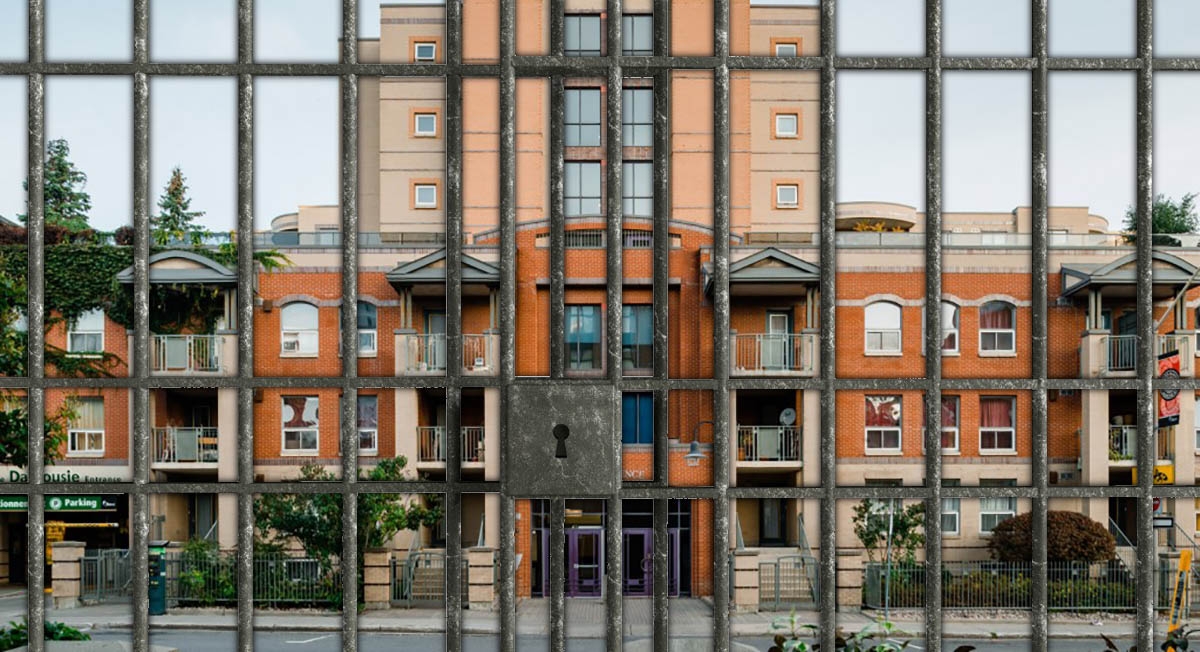
The Fifth Floor
While mistakes happen and human error affects every institution, there is absolutely no excuse for routine neglect for the most vulnerable in society, wherever it may occur. However, it is all the more reprehensible when it happens in a hospital, an institution that exists solely for the care of others. And yet, that is exactly what has happened on the fifth floor of the Saint- Vincent Hospital in Ottawa.
Remarkably and shamefully, even after families shared their horror stories with CTV national news in attempt to get the attention of hospital administration, nothing changed and the horrific treatment remains business as usual.
Since the broadcast, more patients and their family members have come forward with their disturbing experiences on the fifth floor of Saint-Vincent Hospital, where these patients—the most vulnerable in the hospital — live.
Bernard Blais is the CEO of Saint- Vincent and despite the fact that CTV exposed patient allegations of abuse and neglect, Blais said he cannot comment on specific cases because of confidentiality. He also refused to answer questions regarding any past events in the hospital.
Blais has been the CEO for the past two years and while some of the patients’ stories date back to a few years before his time, their issues didn’t stop when he became CEO.
“I wasn’t here—some of that goes back like 40 years if you look carefully,” said Blais.
But many patient complaints are recent, some as recent as this past summer. Joan Williams’ son, Keith, was a fiveyear patient of Saint-Vincent Hospital until he passed away at the beginning of August.
The day before he died he was dropped during a transfer from his bed to his chair. This was a daily routine for Keith, who has been in a semi-coma for his entire stay at Saint- Vincent Hospital.
Williams was visiting her son the morning of the accident.
“They told me to go out of the room and shut the door while they got him into the chair. I peeked in and he was on the floor. It took six people to get him back into the bed,” said Williams who added that the chair broke.
Williams said she noticed the tube for his urine bag was wrapped around the chair, full of urine, and if she hadn’t have told them about the tube, it too, would have broken.
Keith’s fall and later, death, is indicative of all of the treatment he received at Saint-Vincent Hospital. “When I wasn’t there I worried so much about him. Every family member of a patient at Saint-Vincent worries.”
Keith was in a semi-coma and this meant that he couldn’t speak or move but he was aware of his surroundings and Williams said she saw her son cry and she could tell in his face when he was in pain.
“He couldn’t speak for himself but he was suffering so much,” said Williams.
She had a stack of notebooks full of incidents that happened in the hospital as well as photos to prove it. (Williams visited her son every day in the hospital she always carried a camera in her purse.) Williams did not want to publish the photos but they showed everything from massive bed sores, infected toes, a nasty rash on the back of his neck from a dirty feeding tube cord, horrific scars on his face after being shaved. The photos showed Keith lying nearly naked in his bed with a towel draped over him. There were many photos of his head left unsupported and cuts on his forehead from when the harness bar—which helps lower him into his chair, was too low and it would come across and hit him in the head.
When she asked nurses why Keith was in uncomfortable positions their response was that “he must have moved.” Given his semi-coma status, he could not move.
“I just don’t know how they can treat people that way—people who can’t move or talk,” said Williams.
Williams said nurses and hospital staff always let his need for care—whether it was a wound, a bed sore or catheter changing go beyond the limit before dealing with it.
Because hospital staff waited so long before treating Keith, their patient, he constantly had to be taken to The Ottawa Hospital to change his catheter, or get other treatment that should have been given at Saint- Vincent.
“It must have been so painful, the way he was abused. Everything needs change there. They need compassion,” said Williams.
Every time a patient is taken away from Saint-Vincent Hospital and carted off to The Ottawa Hospital, it costs tax dollars for the use of the ambulance and the time of additional staff. It’s also disruptive to the patient, but many families said they were more than happy to go to The Ottawa Hospital.
Lisa Oldham’s mother Elsie Hudak, 67, has been a patient of Saint- Vincent Hospital for seven years.
Elsie has Myasthenia Gravis—a chronic autoimmune disease that progresses slowly over time, causing the person to become very weak and can affect the ability to move the muscles in the face.
Elsie communicates by looking at a keyboard on a computer screen and choosing letters by clicking a device with her thumb. She was abused so many times and hurt so badly that she started documenting what happened on her computer and printing off her notes—she did all of this by using her clicker.
Additional incidents of patient abuses recorded by Oldham and her mother, Elsie:
• Removal of their Nanny camera by hospital staff
• A nurse said she “didn’t know whether to put a pillow over my mom’s head or to hug her.” She still works there.
• “Even internally when we said to them, what is the process of filing a formal complaint—no one has ever answered that in seven years,” Oldham said.
• Cuts on her tongue from cleaning too hard
Oldham said that a nurse read a note addressed to her that said, “you hurt me,” and the letter described what happened. The nurse stole the notes Elsie wrote and so they called the police.
The police suggested they install a nanny camera and they did.
This family is in a different situation than others because Elsie has the ability to communicate. She tells her daughter everything.
Oldham said her mother was being re-positioned and the nurses were so rough with her, they broke her arm. She has also been left sitting in her feces for 15 hours.
She said her mother has done everything she could to protest the rough care she was receiving from specific nurses. Finally, after filing hundreds of complaints, Oldham met with members of the hospital board. Members told her they investigated her complaints but Oldham still hasn’t been granted a copy of the investigation—the report that was said to have been completed two years ago.
According to Oldham, the hospital administration told her that if it provided her a copy of the investigation, it would cost $30.00 and if was provided to her lawyer, it would cost her $300.00. She decided to ask for the copy directly, for the $30.00 fee.
This past July, Oldham dropped off a letter to the hospital, requesting the report. She didn’t hear from the hospital so Oldham followed up with administration and they told her they lost the letter. Oldham said hospital administration contacted her ten days later and said they found the letter. Over a month later, she still hasn’t been granted a copy of the report.
Oldham said she was asked to remove the camera they had in her mother’s room—despite the warning on the door and the fact that the hospital has their own—mute and grainy camera in the room. Elsie said that “…. the government disempowers all patients in long-term hospitals to protect themselves from abuse and incompetence by banning patient nanny cams.”
Oldham, along with other family members, said there is one particular nurse that has caused them a lot of pain and who is still working at Saint- Vincent Hospital.
Nurse management is one of key problems addressed by all family members interviewed and Blais had trouble describing the role of nurse management and leaders on the floor.
“There’s also a go to nurse—I forget what they call—but if the nurse has a particular issue and the manager isn’t there right now and there’s a nurse with more experience I guess—not sure what they’re called, but they can go to for advice or to help them out. So we have all these things in place today,” said the CEO.
Dania Hadi’s father, Hasan, spent the last three years of his life in Saint- Vincent Hospital battling cancer. Hadi documented over 50 events that took place during his time in the hospital.
“Dad got this nurse who didn’t come in—it happened several times—but this one specific time he didn’t come in. The nurse’s shift started at 7 a.m., and it was to end at 3:30 p.m. From 7-2 p.m., when mom walked in, nothing had been done. Dad’s trachea was full, his mouth was full and he was soaked, absolutely drenched. Mom starts screaming ‘ bloody murder,’” said Hadi.
She said her mom’s biggest regret was not calling 911 that day.
Hadi said another significant incident was when her father’s eye had a serious infection. Hadi said the nurses were putting tear drops in his eye instead of antibiotics. The ophthalmologist who she said visited her father once a month in the hospital said that the puss coming out of his eye was a result from pressure from his brain tumour.
Hadi took matters into her own hands. She took a photo of his eye and sent it to a doctor. The doctor followed up by arranging an appointment for her father with the Ottawa Eye Institute.
The first question the Institute asked was why it took so long to get Hasan there. Hadi said that initially, the professionals at the Eye Institute thought the eye was “gone,” but would try to save it by administering heavy antibiotics by the hour.
Hadi said after they purchased the antibiotic there were a slew of other issues.
• Two days passed and there was no antibiotic as the Bruyère pharmacy said it was out of filters needed to make the antibiotic
• After two days the family received the antibiotic but then it went missing.
• The antibiotic—which cost the Hadi family $1500 was found in the disposable needle bin
• Hadi said the nurse refused to refrigerate the same antibiotic because she “didn’t want to make trips to the fridge”
• Finally, the Hadis just put the antibiotic in a glass with ice
Additional incidents recorded by Hadi:
• No baths
• Forgetting medicine (reoccurring)
• No food or water for days
• Bladder infection from blocked catheter
• No follow ups after complaints made to Blais
• Nurse left for break and didn’t return, leaving the family to stop his gavage and reposition him
• Trachea full of secretions. Irrigation on floor
• No one to reposition him • Gavage off (reoccurring)
• Blocked catheter (reoccurring)
• No soap in room
•Many cases of pneumonia
The hospital’s abominable behaviour continued after Mr. Hadi’s death. In May, the family received a letter in the mail from the Bruyère Foundation asking for a donation from Dania’s deceased father.
“The fifth floor is sad.” Hadi also said that after meetings with board members and administration, she never received an apology for how her father was treated or even any condolences when he passed.
Lisa Marie Da Ponte is another patient at Saint-Vincent Hospital. She has been a patient for six years and she has ALS. She uses a similar communication device as Elsie Hudak and when she whispers, her aunt Paulette Layng can hear her.
Layng said she’s been told that changes are coming but her niece has been through a lot. Layng has a 16- page document full of incidents and it includes times, names of nurses and what went wrong.
The most alarming incident of all, though, was when nurses administered the wrong medication—twice.
“I mean she’s going to die, but could she die from her disease as opposed to dying from somebody else’s medication?” said Layng.
Layng said on the first occasion, Lisa was given her roommate’s medication and the second time, the medication she was given belonged to a patient down the hall. Both times, Lisa told the nurse that it wasn’t her medication— and they responded by asking her if she was being difficult and refusing to take her medication.
The second time Lisa was given the wrong medication for four days and she could have been killed.
While medical malpractice, negligence and neglect are major issues on the fifth floor, there is also a lack of compassion.
Layng said that when Lisa was able to travel through the hall by wheelchair, she met a male patient who also had ALS and they fell in love and got married in the hospital.
One of the nurses looked at Lisa’s chart and insensitively asked why she would be on birth control and added that she can’t ‘do anything.’ The birth control pills are to help with her menstruation cycles.
“Her mom and I cried so much, I mean what is the point of this?” said Layng.
Layng said on another occasion, Lisa needed to use the bedpan and the nurse turned to Layng and asked her which way it went.
Layng said she is tired of dealing with issues at Saint-Vincent Hospital and she can only imagine how her niece feels.
“She calls me Ant Paul… ‘Ant Paul, what if I start choking and I ring my bell and they don’t come?’ Can you imagine living like that? Because the bell could go off for an hour,” said Layng.
Layng said there have been some changes and Lisa has been moved to the other side of the fifth floor where she’s been told the patient-nurse ratio is 4 to 1, rather than 7 to 1. Layng keeps in contact with Lisa’s former roommate and she asked her how things were and her response, ‘it’s the same, Paulette.’
Additional incidents recorded by Layng and her niece, Lisa:
• Not answering her call bell— the bell she uses to get nurses’ attention
• Left on the commode for 45 minutes
• Refusing to wash her hair after she’s had an accident (feces in her hair)
• Hurting her neck during transfers or readjustments
• Dropping her
• Not washing her
Despite hundreds of complaints and documented cases of patient abuse, Blais said there is a process in place for dealing with patient issues and that patients on the fifth floor are receiving excellent care.
“The fifth floor is a big floor and if you went there you’d see all the vents and vent patients that are on there. I don’t—I can’t say there’s a problem there. All I know is I believe the care provided there is excellent. I think there’s—you know as you know we’re making some changes there,” said the CEO.
Blais said the hospital was recently granted $50,000 as a Patient and Family Engagement Project, from the Canadian Foundation for Healthcare Improvement. One of the programs will allow family members and patients to be a part of a team with hospital staff to help improve quality of care.
“Every unit-based team has a patient and or family member today. So they should be involved. We really care about the care we provide for our patients and they should be involved in providing input because they’re the ones that know,” said Blais.
But in a recent interview with CFRA 580 regarding the grant, the hospital said it would be concentrating on improving patient transfers into and out of Saint-Vincent Hospital. There was no mention of family member involvement to improve quality care.
This is indicative of the concerns of family members Layng and Oldham— both of them said they haven’t been invited to join a team and they have no knowledge of the patient-family based team initiative.
Following the radio interview, Layng immediately wrote an email to Blais:
“The allegations of neglect and abuse at Saint-Vincent hospitals were concerning real incidents that happened to our loved ones, nothing to do with transition in and out of your facility.”
Despite the incidents on the fifth floor, a recently-discharged patient, said life was good on the third floor. John Marta, 53, said everyone from the nurses to the cleaning staff, food service staff and volunteers were great to him. He had been treated for an ulcer on his foot and cared for when he had pneumonia.
“I looked forward to waking up and seeing what nurse I had because I love them all,” said Marta.
After multiple attempts to contact the Ontario Minister of Health and Long- Term Care, Dr. Eric Hoskins, the office didn’t return emails and phone calls for a statement regarding the allegations at Saint-Vincent Hospital.
Last year, Deb Matthews as Health Minister said in a Globe and Mail interview that the Ontario government would engage more than double the amount of inspectors to review the quality of life in long-term care facilities and this came after reports of neglect in Ontario facilities.
“We’re really beefing up and we’re significantly increasing, more than doubling, the number of inspectors,” Deb Matthews said in the 2013 Globe and Mail story.
Saint-Vincent Hospital is a complex care facility and the fifth floor is the only floor considered to be long term because of the needs of the patients on that floor. According to Blais there are about 80 patients on the fifth floor.
When asked if he empathized with the patients, Blais said, “Well we’ve done more than that we’ve listened to them and they’re on every unit-based quality team.”
After interviewing family members of patients who have filed many complaints, this is clearly not true.
Blais said he’s responded appropriately by having patient and family members on teams—yet the patients on the fifth floor and their families have yet to hear about this development.
Hadi met with Blais and she said he attributed patient care issues to a lack of government funding. Meanwhile, he takes home well over $300,000 a year, not including bonuses. He’s in good company with many other highpaid executives under the umbrella of Bruyère Continuing Care and many nurses also earn salaries well above the $100,000 mark. The salaries would not be so egregious if they actually dealt with situations and provided care.
Financial Breakdowns:
•LHIN—Local Health Integration Network does not fund Bruyère Hospitals separately.
•Based on the $86,486,190 in total LHIN funding received for hospital operations and the OCDM costs by programs, the Saint- Vincent site can be estimated at $58,692,000 (67.8%).
•The total compensation cost for Bruyère Executive Offices amounts to $2,103,000, at the end of 2013/14.
•In the last fiscal year, the Ottawa community designated $1 million for Saint-Vincent Hospital. A detailed breakdown includes of money transfers from the Bruyère foundation to Saint-Vincent Hospital in the last fiscal year: •$940,000 was transferred to Saint-Vincent Hospital for a medicine transformation project,
• $240,000 for equipment needs and;
• $700,000 towards the electronic patient record project at Saint-Vincent Hospital.













